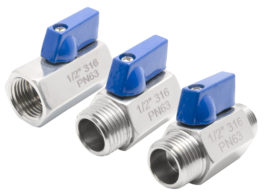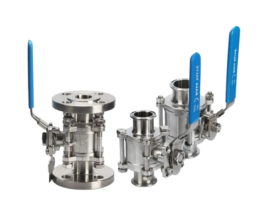Ball Valves
A ball valve is a form of quarter-turn valve which uses a hollow, perforated and pivoting ball to control flow through it. It is open when the ball’s hole is in line with the flow . It is closed when it is pivoted 90-degrees by the valve handle.
The handle lies flat in alignment with the flow when open, and is perpendicular to it when closed. This makes for easy visual confirmation of the valve’s status.
Ball valves in sizes up to 2 inch generally come in single piece, two or three piece designs. One piece ball valves are almost always reduced bore, are relatively inexpensive and generally are throw-away.
Two piece ball valves are generally slightly reduced (or standard) bore, they can be either throw-away or repairable. The 3 piece design allows for the center part of the valve containing the ball, stem & seats to be easily removed from the pipeline.
This facilitates efficient cleaning of deposited sediments, replacement of seats and gland packings. It is also used for polishing out of small scratches on the ball. All this without removing the pipes from the valve body.
The design concept of a three piece valve is for it to be repairable.
Full port
A full port or more commonly known full bore ball valve has an over-sized ball. This is so that the hole in the ball is the same size as the pipeline resulting in lower friction loss.
Flow is unrestricted but the valve is larger and more expensive so this is only used where free flow is required. This is for example in pipelines which require pigging.
Reduced port or reduced bore
In Reduced port (more commonly known as reduced bore) ball valves, flow through the valve is one pipe size smaller than the valve’s pipe size resulting in flow area being smaller than pipe.
Showing all 2 results


